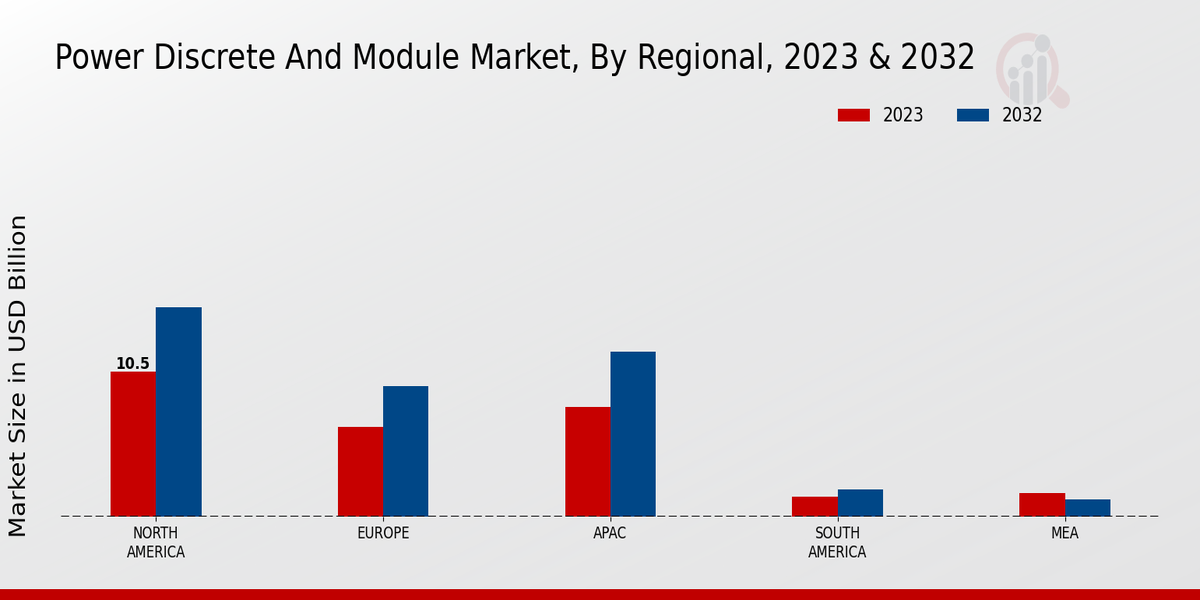Market Growth Projections
The Global Power Discrete and Module Market Industry is poised for substantial growth, with projections indicating a market size of 30.5 USD Billion in 2024 and an anticipated increase to 46.7 USD Billion by 2035. This growth trajectory reflects a compound annual growth rate of 3.94% from 2025 to 2035, driven by factors such as advancements in semiconductor technology, rising electric vehicle adoption, and the expansion of renewable energy sources. These dynamics suggest a robust future for the industry, highlighting the increasing importance of power discrete components and modules in various applications.
Rising Industrial Automation
The trend towards industrial automation is a prominent driver of the Global Power Discrete and Module Market Industry. As industries adopt smart manufacturing practices and Industry 4.0 technologies, the demand for reliable and efficient power management solutions is growing. Power discrete components are integral to automation systems, providing the necessary control and efficiency for various applications. This increasing reliance on automation technologies is expected to propel the market forward, aligning with the projected growth trajectory towards 46.7 USD Billion by 2035.
Growing Demand for Energy Efficiency
The Global Power Discrete and Module Market Industry is experiencing a notable surge in demand for energy-efficient solutions. As industries and consumers increasingly prioritize sustainability, the adoption of power discrete components and modules that enhance energy efficiency becomes paramount. For instance, the integration of advanced semiconductor technologies in power electronics is expected to drive market growth. This shift aligns with global energy policies aimed at reducing carbon footprints, suggesting that the market could reach a valuation of 30.5 USD Billion by 2024, reflecting a growing awareness of energy conservation.
Expansion of Renewable Energy Sources
The Global Power Discrete and Module Market Industry is significantly influenced by the expansion of renewable energy sources. As countries strive to transition towards sustainable energy systems, the demand for power electronics in solar, wind, and other renewable applications is increasing. Power discrete components are essential for efficient energy conversion and management in these systems. This trend is likely to drive market growth, as investments in renewable energy infrastructure continue to rise, supporting the industry's potential to reach a valuation of 30.5 USD Billion by 2024.
Increase in Electric Vehicle Adoption
The rise in electric vehicle adoption is a critical driver for the Global Power Discrete and Module Market Industry. With governments worldwide implementing stringent emissions regulations and offering incentives for electric vehicle purchases, the demand for power electronics in automotive applications is escalating. Power discrete components play a vital role in electric vehicle powertrains, enhancing efficiency and performance. This trend is expected to bolster the market, contributing to a compound annual growth rate of 3.94% from 2025 to 2035, as manufacturers seek to optimize power management solutions for electric vehicles.
Advancements in Semiconductor Technology
Technological advancements in semiconductor materials and manufacturing processes are significantly influencing the Global Power Discrete and Module Market Industry. Innovations such as wide bandgap semiconductors, including silicon carbide and gallium nitride, are enhancing performance and efficiency in power applications. These materials allow for higher voltage and temperature operations, which are crucial for applications in electric vehicles and renewable energy systems. As these technologies mature, they are likely to contribute to a projected market growth to 46.7 USD Billion by 2035, indicating a robust trajectory driven by technological evolution.























Leave a Comment